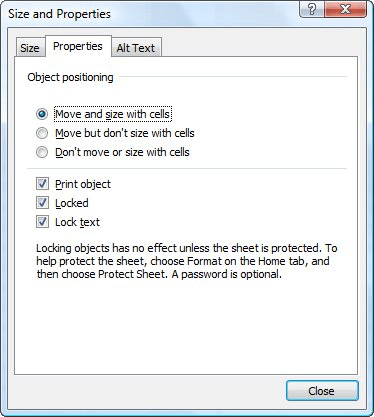Please Note: This article is written for users of the following Microsoft Excel versions: 2007, 2010, 2013, 2016, 2019, 2021, and Excel in Microsoft 365. If you are using an earlier version (Excel 2003 or earlier), this tip may not work for you. For a version of this tip written specifically for earlier versions of Excel, click here: Hiding Graphics when Filtering.
Written by Allen Wyatt (last updated September 14, 2024)
This tip applies to Excel 2007, 2010, 2013, 2016, 2019, 2021, and Excel in Microsoft 365
James has a worksheet that has graphics on top of cells that explain what is in the cells. The graphics sort with the cells just fine, but when he applies filters to the cells, the graphics bunch up at top of cells that are visible. James wonders if there is a way to have graphics hide when filtering data within cells.
The answer has to do with how you have the properties for the graphics set up. You need to make sure that the graphics are set to resize when the row height changes. Here's what you do if you are using Excel 2013 or a later version:

Figure 1. The Properties option of the Format Picture task pane.
If you are using Excel 2007 or Excel 2010, then the process is just a bit different because those versions don't use task panes. Follow these steps:

Figure 2. The Properties tab of the Size and Properties dialog box.
Regardless of your version of Excel, it is step 5 that does the trick. Since your graphics are sorting properly when you sort the worksheet, chances are good that you had the Move but Don't Size with Cells check box selected. This is what caused the graphics to bunch up—they couldn't resize when filtering hid the rows with which they were associated.
ExcelTips is your source for cost-effective Microsoft Excel training. This tip (11763) applies to Microsoft Excel 2007, 2010, 2013, 2016, 2019, 2021, and Excel in Microsoft 365. You can find a version of this tip for the older menu interface of Excel here: Hiding Graphics when Filtering.

Best-Selling VBA Tutorial for Beginners Take your Excel knowledge to the next level. With a little background in VBA programming, you can go well beyond basic spreadsheets and functions. Use macros to reduce errors, save time, and integrate with other Microsoft applications. Fully updated for the latest version of Office 365. Check out Microsoft 365 Excel VBA Programming For Dummies today!
Worksheets can contain more than just text and numbers. Here's the low-down on the different types of pictures you can ...
Discover MoreIf you need to arrange a group of graphics so that they are evenly distributed between a starting point and an ending ...
Discover MoreCreate a simple drawing object, and Excel makes some assumptions about how that object should appear. Excel provides a ...
Discover MoreFREE SERVICE: Get tips like this every week in ExcelTips, a free productivity newsletter. Enter your address and click "Subscribe."
2024-09-16 10:35:39
J. Woolley
Excel graphics are called shapes. They can be grouped and/or linked to a formula, macro, or hyperlink. My Excel Toolbox includes the following dynamic array function to list information about a workbook's shapes:
=ListShapes([AllSheets], [SkipHeader], [IncludeText])
These 7 columns are returned for each shape: Range, Group, Type, Shape Name, Link Formula, Macro Name, and Hyperink Address. If optional IncludeText is TRUE (default is FALSE), an 8th column will include Shape Text.
See https://sites.google.com/view/MyExcelToolbox/
Got a version of Excel that uses the ribbon interface (Excel 2007 or later)? This site is for you! If you use an earlier version of Excel, visit our ExcelTips site focusing on the menu interface.
FREE SERVICE: Get tips like this every week in ExcelTips, a free productivity newsletter. Enter your address and click "Subscribe."
Copyright © 2025 Sharon Parq Associates, Inc.
Comments